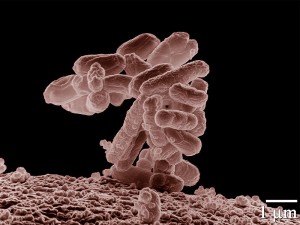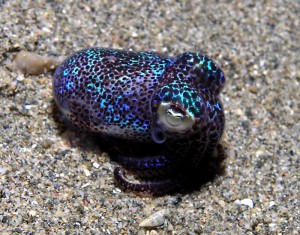
As studies of symbiosis progress, scientists are beginning to think of organisms as communities rather than individuals. Plants live with fungi that help obtain nitrogen; fig trees provide homes for wasp larvae in donated flowers; leaf cutter ants carry around bacteria that provide antibiotics which protect their fungi gardens from disease (Zhang et al, 2007). But what about our own communities? That’s a question in recent years that has prompted the creation of the Human Microbiome Project, which aims to genetically sequence the bacteria living in our gut, urogenital tract, skin, and nasal/oral caveties in the hopes of understanding the diversity of bacteria within humans and its role in our health.

Just thinking about the mere numbers of bacteria living as part of your body will make you wonder what exactly their role is. Swabbing a small portion of your skin captures 10,000 bacteria (Grice et al, 2008), and that number doesn’t even compare to the amount of microbes that live in your intestinal tract: 1013 (Gill 2006) – that’s a whopping 100,000,000,000,000 bacteria – almost ten times the national debt! Your skin alone is home to thousands of species of bacteria, and the composition of this community varies among individuals as well as among areas of your body (Grice et al, 2009; Gao et al, 2007). Although bacteria tend to have a bad reputation, whether because of meningitis, strep throat, or Escherichia coli outbreaks, we can assume that they are not all bad since we are a host to so many and we probably wouldn’t be alive if they were all bad. In fact, our normal bacteria flora is important in digestion, immune response, and vitamin synthesis. Altered proportions of the gut bacteria groups Bacteroidetes and Firmicutes have been shown to change the digestive capacity of humans, and are suggested to be one of the components of obesity (Lev et al, 2006). The roles of many of our bacteria are unknown but the Human Microbiome Project is likely to make available many more bacteria for analysis.

One beautiful example of a symbiosis outside of the anthroposphere that I would like to quickly share with you is that of the Hawaiian bobtail squid (Euprymna scolopes) and the bioluminescent bacterium Vibrio fischeri. This particular squid uses the dull blue bioluminescence of V. fischeri to disperse its moonlit shadow, so that it is less visible to predators. Among small hair-like structures within the squid’s light organ, V. fischeri create colonies that glow only once they reach a certain density. Squids expel 90% of their V. fischeri daily to create a cyclical pattern of glowing that matches the rise and fall of the moon. When the moon is at its brightest, the light organ on the bottom side of the squid shines the most; both organisms synchronize their metabolisms to optimize energy use for luminescence. At night, the squid provides oxygen and generates chitin to support the bacteria so that it can respire aerobically (more efficient) and glow more brightly, while during the day, the squid downregulates chitin production, forcing the bacteria to respire anaerobically (less efficient) and produce less of a glow (Weir et al, 2010).
Evolution leads many organisms to cooperate in order to survive, creating diverse communities of animals and microbes. Let us not take our flora for granted, for it is most likely important in a number of processes.
_____________
Thanks to Rachel Golden for her assistance in the background research for this article.
Gao, Z, C Tsent, Z Pei, and R Blaser. 2007. Molecular analysis of human forearm superficial skin bacterial biota. PNAS 104(8): 2927-2932.
Gill, SR. 2006. Metagenomic analysis of the human distal gut microbiome. Science 312: 1355–1359.
Grice, EA, HH Kong, G Renaud, AC Young, GG Bouffard, RW Blakesley, TG Wolfsbert, ML Turner, and JA Segre. 2008. A diversity profile of the human skin microbiota. Genome Res 18:1043-1050.
Grice, EA, HH Kong, S Conlan, CB Deming, J Davis, AC Young, NISC, GG Bouffard, RW Blakesley, PR Murray, ED Green, ML Turner, and JA Segre. 2009. Topographical and temporal diversity of the human skin microbiome. Science 324(5931): 1190-1192.
Lev, RE, PJ Turnbaugh, S Klein, and JI Gordon. 2006. Microbial ecology: human gut microbes associated with obesity. Nature 444(7122):1022-1023.
Weir, AM, SV Nyholm, MJ Mandel, RP Massengo-Tiasse, AL Shaefer, I Koroleva, S Splinter-Bondurant, B Brown, L Manzella, E Snir, H Almabrazi, TE Scheetz, F Bonaldo, TL Casavant, MB Soares, JE Cronan, JL Reed, EG Ruby, and MJ McFall-Ngai. 2010. Transcriptional patterns in both host and bacterium underlie a daily rhythm of anatomical and metabolic change in a beneficial symbiosis. PNAS 107(5): 2259-2264.
Zhang, MM, M Poulsen and CR Currie. 2007. Symbiont recognition of mutualistic bacteria byAcromyrmex leaf-cutting ants. The ISME Journal 1: 313–320.


Becca I love this post!! Simply beautiful
Thanks Cait! 🙂
Wonderful post Becca. The BBC website posted this news item today.
Human gut microbes hold ‘second genome’
http://news.bbc.co.uk/1/hi/sci/tech/8547454.stm
“Basically, we are a walking bacterial colony,” said Professor Jeroen Raes, one of the researchers involved. “Gut flora is crucial for our health. We’re basically living in symbiosis with these microbes.”